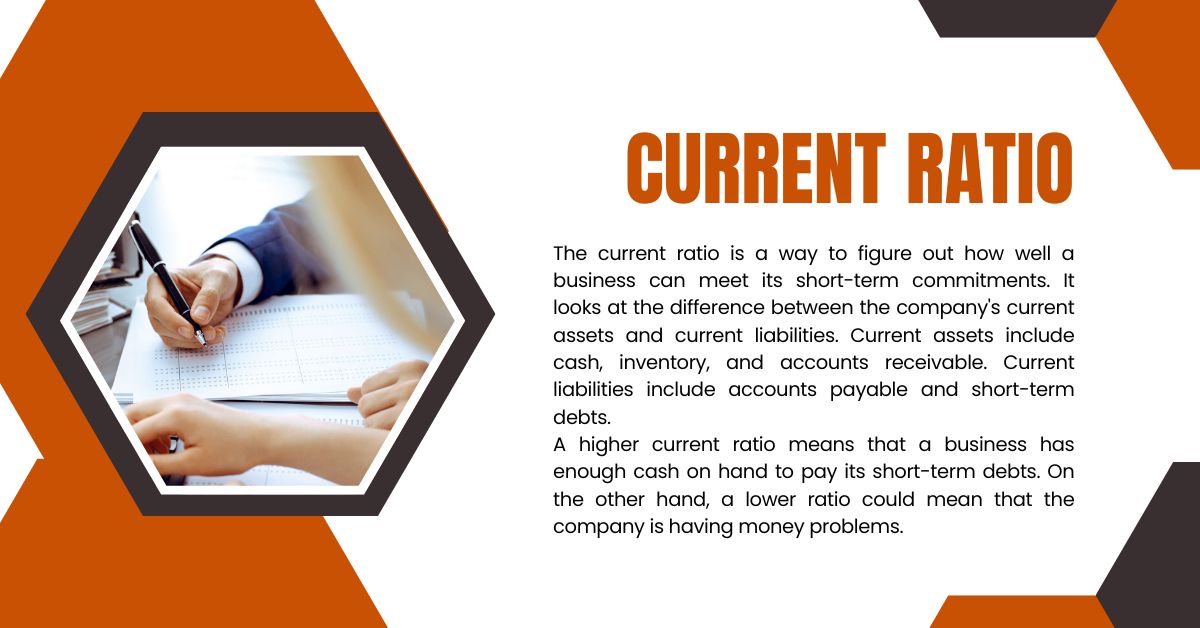Accountants and finance experts use the current ratio to figure out how financially stable a company is at any given time. This number compares a company’s current assets (things it can quickly turn into cash) to its current liabilities (things it owes money to clients and lenders).
What is Current Ratio?

The current ratio is a way to figure out how well a business can meet its short-term commitments. It looks at the difference between the company’s current assets and current liabilities. Current assets include cash, inventory, and accounts receivable. Current liabilities include accounts payable and short-term debts.
A higher current ratio means that a business has enough cash on hand to pay its short-term debts. On the other hand, a lower ratio could mean that the company is having money problems.
Current Ratio Formula
To find the current ratio, use this formula:
Current Ratio = Current Assets / Current Liabilities
For example, if a company has current assets of $100,000 and current liabilities of $50,000, its current ratio would be 2:1. This means that the business has twice as many current assets as current expenses, which is a good sign for its finances. It is important to keep in mind, though, that the best current ratio can be different for each business and company.
How the Current Ratio Works?
To use the current ratio, do the following:
- Find the company’s current assets. These are its assets that can be turned into cash within a year. Examples of these are cash, accounts receivable, inventory, and costs that have already been paid for.
- To find the company’s current liabilities, add up all of its debts that are due within a year. This includes accounts payable, short-term loans, and bills that have already been paid.
- Split your current possessions by your current debts: The ratio that comes out shows how well the company can pay its short-term bills.
Who Uses this Ratio?
The current ratio is a fundamental financial metric that many people use to judge the overall health of a business. The following significant groups use the current ratio:
- Investors: Investors use the current ratio to assess how liquid a company is and whether it can fulfill its short-term commitments. A high current ratio can mean that the company is doing well financially, while a low current ratio may make people worry about the company’s ability to pay its bills.
- Creditors: Before giving a company a loan or credit, lenders like banks and sellers look at the current ratio to see how creditworthy it is. If a company has a high current ratio, it means it is more likely to pay its bills on time.
- Management: To monitor the company’s cash flow and spot any potential issues, management uses the current ratio. If a company has a low current ratio, it might need to improve how it handles its cash or lower its short-term debts.
- Financial analysts use the current ratio to assess how well a company’s finances are doing overall and to compare its financial performance to industry benchmarks.
- Regulatory bodies: Government organizations and regulatory bodies can use the current ratio to monitor how financially stable businesses are in specific industries, like banks and insurance.
Current Ratio vs. Other Liquidity Ratios
| Ratio | Definition | Formula | Interpretation |
|---|---|---|---|
| Current Ratio | Measures a company’s ability to pay short-term obligations with current assets. | Current Assets / Current Liabilities | A higher ratio indicates better liquidity. |
| Quick Ratio (Acid Test Ratio) | Measures a company’s ability to pay short-term obligations with its most liquid assets. | (Current Assets – Inventory) / Current Liabilities | A higher ratio indicates better liquidity, especially for companies with high inventory levels. |
| Cash Ratio | Measures a company’s ability to pay short-term obligations with cash and cash equivalents. | (Cash + Cash Equivalents) / Current Liabilities | A higher ratio indicates excellent liquidity but may also suggest inefficient use of resources. |
| Working Capital Ratio | Measures a company’s excess of current assets over current liabilities. | Current Assets – Current Liabilities | A positive ratio indicates sufficient working capital to meet short-term obligations. |
Want to read more about financial ratios? You can read this ratio by clicking the links given below:
- What is PEG Ratio in Share Market? Balancing Price, Earnings, and Growth
- What Is Debt To Equity Ratio? The Ratio That Reveals A Company’s True Story
What Is a Good Current Ratio?
What is considered a “good” current ratio can change based on the business and its circumstances. A present ratio of 1.5 to 3 is usually thought to be healthy. Retail and manufacturing, on the other hand, may have smaller ideal ratios because their inventory changes so quickly.
If the ratio is less than 1, it means that the company might have trouble meeting its short-term commitments. A very high ratio, like above 3, on the other hand, could mean that the company has too much cash or inventory, which could make it less successful.
To get a full picture of a company’s financial health, it’s important to look at the current ratio along with other financial measures and industry standards.
What Happens If the Current Ratio Is Less Than 1?
If a business has a current ratio less than 1, it means that its current debts are higher than its current assets. This means the business might have trouble meeting its short-term responsibilities, like paying its bills and back loans.
If the current ratio is less than 1, it could mean that the business is having trouble making money, which could make investors, debtors, and management nervous. It might be hard for the business to get new loans or work out good deals with providers. If the current ratio stays low for a long time, it can cause the company to go bankrupt.
What Does a Current Ratio of 1.5 Mean?
A current ratio of 1.5 means that for every $1.00 in current liabilities, a company has $1.50 in current assets. This usually means that the company’s finances are in good shape and that it has enough money to meet its short-term commitments.
A current ratio of 1.5 is often thought to be a good starting point, but the best ratio for a company can change based on its industry and its unique circumstances. Some examples of ideal ratios that might be smaller are those in retail and manufacturing, where inventory changes hands a lot.
As long as the current ratio is 1.5, it means that the company has enough cash on hand to handle any unexpected costs or changes in the business environment.

